How the Black Prince charged into Leeds


The answer was simple. In history there was no figure with local associations heroic enough for the site. It was essential an equestrian statue should be selected; the difficulty was to find the subject. Henry de Lacy, the Crusader, has a place in local traditions by reason of the share he is reputed to have taken in the foundation of Kirkstall Abbey, but it was thought crucial for a larger figure in the national history to be represented. At that time there were no memorials of the great Duke of Marlborough, of Henry V, or of Edward III, and his son, the Black Prince.
The choice fell on the romantic personality of the Black Prince, born in 1330. The origins of the Black Prince name are uncertain. Theories suggest it is derived from his black shield as well as black armour; or that it was applied from a brutal reputation, particularly towards the French.
Advertisement
Hide AdAdvertisement
Hide AdDuring Edward the Third’s reign, England stood proud as a world power.


Then began the great struggle with France which, with one interruption, went on with varying fortunes for around 120 years. After the Black Prince’s death in 1376, the tide of war turned against Britain until some 40 years later came Henry the Fifth’s victory at Agincourt.
The Black Prince sculpture was commissioned by industrialist Colonel Thomas Walter Harding.
Born in 1843 at Lille, France, where his Leeds-based father had a factory, he was educated at Leeds Grammar School, and later built extensions to the Tower Works in Holbeck in 1899 and the 1920s.
Advertisement
Hide AdAdvertisement
Hide AdHe proposed and financed a number of sculptures when City Square was remodelled to create an open space to mark Leeds’s elevation from town to city in 1893. The site had formerly been occupied by the Coloured Cloth Hall and Quebec House. William Bakewell was engaged as architect and work began in 1897.
Mayor of Leeds 1898-1899, Harding entrusted the Black Prince project to sculptor Thomas Brock (1847-1922) who had come to prominence with his Prince Albert statue for the Albert Memorial, unveiled in 1872.
Brock’s Leeds sculpture was his most significant provincial commission and, praised as being careful in its detailing and powerful in its impact.
Supporting the Prince is a pedestal with relief panels, depicting land and sea battles, evoking his heroism against France. The base also includes a scroll of names. One of these is Van Artevelde, the democratic ruler of the Flemish States, whose influence on Edward III led the English King to encourage the weavers, fullers and dyers of cloth to come over, not only to Norfolk, but to the West Riding.
Advertisement
Hide AdAdvertisement
Hide AdBrock took seven years to complete the work which had to be cast in Belgium, being too large for a foundry in Britain. On completion the bronze was conveyed by barge from Hull along the River Aire to Leeds.
Brock was at hand when workmen, rising at dawn, lifted the enormous piece into position. Later, he would be noted for creating the Queen Victoria Memorial, another work of immense proportions, in the Mall, London.
In Leeds, the Black Prince is central in a circular raised platform about 100 feet in diameter and surrounded by a balustrade of polished marble. Placed on this balustrade were eight statues of allegorical figures representing “Morn” and “Even” and they were executed by Alfred Drury (1856 -1944).
Two triangular spaces terminate an outer balustrade on the Post Office side, and on this particular stretch statues of Joseph Priestley (Scientist), Dean Hook (Divine), John Harrison (philanthropist), and James Watt (inventor) were positioned.
Advertisement
Hide AdAdvertisement
Hide AdBesides the Black Prince, Harding presented all the other statuary in the City Square with the exception of the John Harrison and James Watt pieces.
The Black Prince was unveiled in front of thousands of spectators at noon, September 16 1903.
Flags waved from many a building and occupants peeked from windows.
Shortly after noon, Colonel Harding, was greeted by loud cheers as he made a formal presentation of the monuments .
Advertisement
Hide AdAdvertisement
Hide AdIn spite of some criticism, he had no regrets in selecting the Black Prince to dominate the square. He said the hero of Crecy and Poitiers, the flower of English chivalry, the upholder of the liberties of the English people, would remain an emblem of manly and unselfish virtues which.
In another ceremony later in the day, at the Victoria Hall, Harding was created a Freeman of the City.